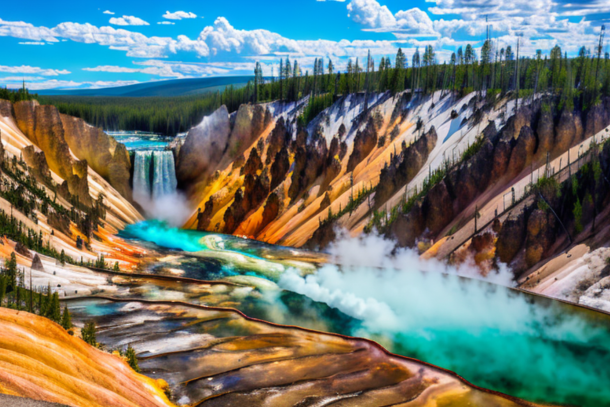The Healing Power of Nature: Forest Bathing Explained

Forest bathing, known as shinrin-yoku in Japanese, is a practice that involves immersing oneself in nature and absorbing the forest atmosphere through all senses.
Unlike traditional hiking, which often focuses on reaching a destination, forest bathing emphasises slowing down and being mindful of the natural surroundings. This practice encourages individuals to engage with nature on a deeper level, promoting relaxation and a sense of well-being.
Historical Background and Origins in Japan
The concept of shinrin-yoku was developed in Japan in the 1980s as a response to the country's increasing urbanisation and technological advancements. As people spent more time indoors and experienced higher levels of stress, the Japanese government introduced forest bathing as a public health initiative. The idea was to reconnect individuals with nature and provide a natural remedy for stress and burnout. Over the years, numerous studies in Japan and around the world have validated the health benefits of forest bathing, making it a widely recognised practice for enhancing mental and physical health.
The purpose of this article is to delve into the concept of forest bathing and its numerous benefits. By exploring its origins, understanding its practices, and highlighting its positive impacts on mental and physical well-being, we aim to encourage readers to incorporate forest bathing into their lives. Whether you are looking to reduce stress, improve your mood, or simply reconnect with nature, this article will provide valuable insights and practical tips to help you experience the healing power of the forest.
What is Forest Bathing?
Definition and Origins
Forest bathing, known as shinrin-yoku in Japanese, is the practice of immersing oneself in a forest environment to promote mental and physical well-being. Unlike typical outdoor activities, forest bathing focuses on mindfulness and a deep connection with nature. This practice involves spending time in a forested area, engaging all five senses to fully experience the surroundings.
Forest bathing has its roots in Japan, where it was developed in the 1980s as a response to the increasing stress and health issues associated with urban living. The Japanese Ministry of Agriculture, Forestry, and Fisheries coined the term shinrin-yoku, which translates to "forest bathing." This practice was designed to encourage people to reconnect with nature and counteract the negative effects of modern, high-stress lifestyles.
The philosophy behind forest bathing is deeply connected to mindfulness, emphasising the importance of being present and fully engaged in the moment. By focusing on the sights, sounds, smells, and textures of the forest, individuals can achieve a state of relaxation and mental clarity. This mindful engagement with nature helps to reduce stress, enhance mood, and improve overall health.
How Forest Bathing Differs from Hiking
While both forest bathing and hiking involve spending time in nature, there are key differences between the two activities. Forest bathing is a mindful and immersive experience, prioritising sensory engagement and a slow pace. Unlike hiking, which often focuses on reaching a destination or achieving a physical challenge, forest bathing encourages participants to move slowly and intentionally, allowing ample time to observe and appreciate their surroundings.
The emphasis in forest bathing is on slow, deliberate movement and deep sensory awareness. Participants are encouraged to take their time, noticing the intricate details of the forest, such as the rustling of leaves, the smell of the earth, and the play of light through the trees. This intentional approach helps to foster a deeper connection with nature and promotes a sense of calm and well-being.
In summary, forest bathing is a mindful practice that encourages a deep connection with nature through slow, intentional movement and sensory engagement. Its roots in Japanese culture highlight the importance of mindfulness and the therapeutic benefits of spending time in natural environments.
Benefits of Forest Bathing
Mental Health Benefits
Forest bathing offers numerous mental health benefits, making it a valuable practice for those seeking to reduce stress and improve emotional well-being. One of the primary advantages is the reduction in stress and anxiety levels. Spending time in a natural environment has been shown to lower cortisol levels, the hormone associated with stress. This can lead to a significant decrease in feelings of anxiety and tension.
Another notable benefit is the improvement in mood and emotional well-being. The serene and calming atmosphere of a forest can uplift your spirits and provide a sense of peace and contentment. Regular forest bathing can also lead to enhanced mental clarity and focus, as the immersive experience allows the mind to relax and reset, improving cognitive function and concentration.
Physical Health Benefits
Forest bathing is not only beneficial for mental health but also has several positive effects on physical health. One of the key benefits is a boosted immune system function. Exposure to phytoncides, which are natural compounds released by trees, can enhance the activity of natural killer cells in the body, helping to fight off infections and diseases.
Additionally, forest bathing can lead to lowered blood pressure and heart rate. The calming effect of the natural environment can reduce cardiovascular strain, promoting heart health. Participants often experience increased energy levels and overall physical wellness as a result of regular engagement in this practice, feeling revitalised and more physically active.
Social and Environmental Benefits
Engaging in forest bathing also offers significant social and environmental benefits. It can help in strengthening connection to nature, fostering a deeper appreciation for the natural world. This practice encourages individuals to develop a sense of environmental stewardship and responsibility, leading to increased environmental awareness and conservation efforts.
Moreover, forest bathing provides opportunities for social interaction and community building. Group sessions or guided walks can create a sense of camaraderie and shared experience, helping individuals to connect with others who share similar interests in nature and well-being. These social interactions can further enhance the overall benefits of forest bathing, making it a holistic practice that nurtures both individual health and community bonds.
How to Practise Forest Bathing
Preparing for Your Forest Bathing Experience
Choosing the Right Location
Selecting an appropriate forest or woodland area is crucial for a successful forest bathing experience. Look for a location that offers a variety of natural features, such as a mix of trees, plants, and water sources. Ensure the area is safe and accessible, with well-marked paths. National parks, nature reserves, and local woodlands are excellent choices.
What to Wear and Bring
Dressing appropriately is essential for comfort and safety. Wear layers of breathable, weather-appropriate clothing and sturdy, comfortable footwear suitable for uneven terrain. Bring a small backpack with essentials such as water, a snack, a journal, and a pen. A sit mat or blanket can be useful for moments of rest and reflection.
Setting Intentions
Before beginning your forest bathing session, take a moment to set intentions. Consider what you hope to achieve, whether it's relaxation, clarity, or simply a deeper connection with nature. Setting intentions can help focus your mind and enhance the overall experience.
Step-by-Step Guide to Forest Bathing
Arrival and Grounding
Upon arrival, take a few moments to ground yourself. Stand still, close your eyes, and take deep breaths. Feel the ground beneath your feet and listen to the sounds of the forest. This helps to establish a connection with your surroundings.
Engaging the Senses
Engage all your senses to fully immerse yourself in the experience. Observe the different shades of green, listen to the rustling leaves and bird songs, and feel the textures of tree bark and leaves. Smell the earthy scents of the forest and, if safe, taste edible plants or fruits.
Slow Walking and Mindful Movement
Move slowly and deliberately through the forest. Pay attention to each step, noticing the sensation of your feet touching the ground. Mindful walking helps to deepen your connection with nature and allows you to notice details you might otherwise overlook.
Reflection and Gratitude
At the end of your session, find a quiet spot to sit and reflect on your experience. Write down your thoughts and feelings in your journal. Take a moment to express gratitude for the time spent in nature and the benefits you have received.
Guided Forest Bathing Sessions
Benefits of Joining a Guided Session
Participating in a guided forest bathing session can enhance your experience, especially if you are new to the practice. Guides are trained to help you connect more deeply with nature and provide structured activities that enrich your session.
How to Find a Certified Forest Bathing Guide
Look for certified guides through professional organisations such as the Association of Nature and Forest Therapy or similar groups. Many offer online directories and resources to help you find qualified guides in your area.
What to Expect from a Guided Forest Bathing Experience
In a guided session, you can expect a structured experience that includes introductions, guided sensory activities, and opportunities for personal reflection. Guides may also offer insights into the local flora and fauna, enhancing your understanding and appreciation of the natural environment.
Tips for Incorporating Forest Bathing into Daily Life
Regular Nature Visits
Suggestions for Integrating Forest Bathing into a Busy Schedule
Incorporating forest bathing into a hectic lifestyle may seem challenging, but it is entirely achievable with a few adjustments. Start by scheduling short, regular visits to nearby natural spaces. Even a 20-minute walk in a local park can provide significant benefits. Consider integrating these visits into your daily routine, such as taking a walk during your lunch break or after work.
Local Parks and Green Spaces as Alternatives to Forests
While dense forests provide an ideal setting for forest bathing, local parks and green spaces can be excellent alternatives. Seek out areas with ample tree cover and diverse plant life to mimic the forest experience. Urban green spaces, botanical gardens, and nature reserves can offer similar tranquillity and opportunities for sensory engagement.
Encouraging Family and Friends to Join
Forest bathing can be a shared activity, making it an excellent opportunity to bond with family and friends. Invite others to join you on your nature visits, promoting collective well-being and fostering a deeper connection with each other and the environment. Group outings can also provide additional motivation and enjoyment.
Combining Forest Bathing with Other Practices
Integrating Mindfulness and Meditation with Forest Bathing
Enhance your forest bathing experience by incorporating mindfulness and meditation techniques. Focus on your breathing, the sounds of nature, and the sensations underfoot. This integration can deepen your relaxation and heighten your sensory awareness.
Using Forest Bathing as a Complement to Yoga or Tai Chi
Combine forest bathing with practices like yoga or tai chi for a holistic approach to wellness. Performing these activities in a natural setting can amplify their benefits, as the serene environment helps to reduce stress and improve mental clarity.
Journaling and Creative Activities Inspired by Nature
Bring a journal with you to document your forest bathing experiences. Write about your observations, thoughts, and feelings during your time in nature. Additionally, engage in creative activities such as sketching or photography to capture the beauty around you and express your connection to the natural world.
Overcoming Barriers
Addressing Common Challenges (e.g., Lack of Time, Accessibility)
Common barriers to forest bathing include a lack of time and accessibility to natural spaces. To overcome these challenges, start with small, manageable steps. Short, frequent visits to nearby parks can be just as beneficial as longer excursions. Use weekends or days off to explore further afield.
Tips for Urban Dwellers and Those with Limited Access to Nature
Urban dwellers can still enjoy the benefits of forest bathing by seeking out city parks, green rooftops, or community gardens. These areas can provide a much-needed escape from the urban environment. Additionally, consider joining local nature groups or outdoor clubs to discover hidden green spaces in your city.
Creative Solutions for Bringing Elements of Forest Bathing Indoors
When access to outdoor spaces is limited, bring elements of nature indoors. Decorate your living space with plants, use essential oils with natural scents, and play recordings of natural sounds. These small changes can help create a calming, nature-inspired environment within your home.
By incorporating these tips into your daily life, you can enjoy the numerous benefits of forest bathing, regardless of your schedule or location.
Scientific Research and Evidence
Studies Supporting Forest Bathing
Numerous scientific studies have highlighted the benefits of forest bathing, providing robust evidence for its positive impact on both physiological and psychological health. Research conducted in Japan, where the practice originated, has shown that spending time in forested environments can significantly reduce levels of cortisol, the hormone associated with stress. Participants in these studies often report feeling more relaxed and less anxious after just a short session of forest bathing.
In addition to stress reduction, forest bathing has been linked to improved immune system function. One study found that individuals who spent time in a forest had increased levels of natural killer (NK) cells, which play a crucial role in fighting off infections and cancer. The presence of phytoncides, natural compounds released by trees, is believed to contribute to this immune-boosting effect.
Physiological and Psychological Benefits
The physiological benefits of forest bathing extend beyond the immune system. Regular practice has been associated with lower blood pressure and reduced heart rate, contributing to overall cardiovascular health. On a psychological level, forest bathing can enhance mood, increase energy levels, and improve mental clarity and focus. Testimonials from participants often highlight feelings of rejuvenation and a deeper connection to nature.
Testimonials and Case Studies
Many individuals who have incorporated forest bathing into their routines share compelling stories of transformation. Case studies reveal that people with chronic stress, anxiety, or depression have experienced significant improvements in their symptoms through regular forest bathing sessions. These personal accounts add a valuable layer of evidence to the scientific findings, demonstrating the real-world impact of this practice.
Ongoing Research
The field of forest bathing continues to evolve, with ongoing research exploring new dimensions of its benefits. Current studies are examining the long-term effects of regular forest bathing on mental health, cognitive function, and overall well-being. There is also growing interest in the potential for forest bathing to be integrated into healthcare and therapeutic settings. Researchers are investigating how this practice can be used as a complementary therapy for patients with various conditions, from chronic pain to mental health disorders.
As the body of evidence supporting forest bathing expands, its potential applications in promoting health and wellness become increasingly apparent. The scientific community's interest in this area underscores the importance of reconnecting with nature and the profound impact it can have on our lives.
In this article, we have delved into the concept of forest bathing, also known as shinrin-yoku, and explored its numerous benefits. Forest bathing involves immersing oneself in a forest environment, engaging the senses, and moving mindfully through the natural surroundings. We highlighted the mental health benefits, such as reduced stress and anxiety, improved mood, and enhanced mental clarity. Physical health benefits include boosted immune function, lowered blood pressure, and increased energy levels. Additionally, forest bathing fosters a deeper connection to nature and promotes environmental awareness and conservation.
We encourage you to explore the practice of forest bathing and experience its myriad benefits for yourself. This simple and accessible activity can be integrated into your routine, whether you have access to vast forests or smaller green spaces. Forest bathing requires no special equipment or training, making it easy for anyone to start. By spending time in nature and engaging with your surroundings mindfully, you can enhance your overall well-being and develop a stronger bond with the natural world.
By following the guidelines provided in this article, you can gain a comprehensive understanding of forest bathing, its benefits, and how to incorporate it into your daily life. Embrace the opportunity to connect with nature and enjoy the profound positive impact it can have on your mental and physical well-being.
Related to this article are the following:
- Grounding Techniques for Anxiety: A Comprehensive Grounding Guide
- The Magic Touch: How Massage Enhances Wellbeing and Promotes Restful Sleep
- Revolutionizing Workplace Wellness: An Enthusiast's Guide to Office Massage Chairs
- How mindfullness is helping your wellbeing
- Vitamin D Uncovered: Identifying the Foods Rich in the Sunshine Vitamin and Their Impact on Health
I do hope you have enjoyed this article and hope that you will subscribe to my newsletter so you can get the latest information about all things naturally relaxing.
Stay in touch, join the Naturally Relaxing Newsletter
Newsletter Signup
Post Your Comments
or post as a guest
Be the first to comment.
Latest articles in Nature

Exploring the UK’s Most Serene Coastal Trails

Sustainable Gardening: Tips for Growing Your Own Herbs

The Yellowstone Supervolcano: A Sleeping Giant

The Lost City of Atlantis: A Geological Mystery

The Great Barrier Reef: A Geological Gem and Biodiversity Beacon






